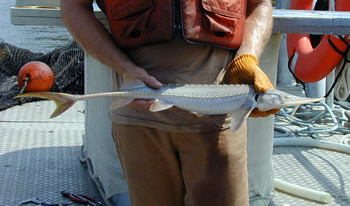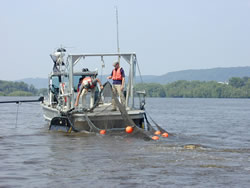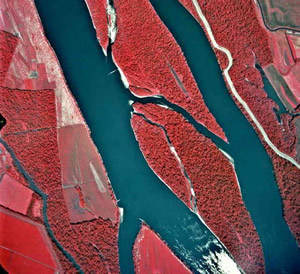Upper Midwest Environmental Sciences Center
The Importance of Deep Channels to the Production of Riverine Fishes
|
Two broad theories—the river-continuum and flood-pulse concepts—have been invoked to describe production processes in streams and rivers 1. These theories differ, in part, in the relative roles ascribed to channels and floodplains in generating this high biological production. The channels of large river-floodplain systems typically have been considered less productive and less hospitable to many organisms than floodplain backwaters. In particular, the main channel has been considered primarily as a pathway used by most fish to move between suitable habitats, although it is recognized that some fish do spend at least some of their time in the main channel. Such movement might occur as fish move from summer and fall habitats to overwintering areas, as fish move from wintering habitats to spawning areas, as a means of dispersal, or as migrations to exploit distant food resources. The Upper Midwest Environmental Sciences Center has unequalled capability to work in the deep channels of large rivers. Although quantitative sampling in deep river channels is difficult, we have demonstrated the effectiveness of trawling for estimating spatial and temporal patterns in abundance and biomass of fish in the main channel of the Mississippi River 2. We found substantial biomass of fish in the main channel, including persistent year-round residents, such as the shovelnose sturgeon (Scaphirhynchus platorhynchus). |
|
Our ongoing program of research seeks to achieve the following objectives:
|
|
|
Current work focuses on the first objective, above. Our objective is to determine whether chronic disturbance by commercial navigation in the Mississippi River has an effect on the abundance and biomass of fish. We are conducting bottom-trawl surveys in matched areas of navigation channel and morphometrically similar secondary channel within low- and high-traffic reaches of the Upper Mississippi River. If commercial navigation traffic has no effect on local abundance of fish, then any differences between the segments of navigation channel and matched adjacent secondary channel would be unrelated to the intensity of navigation traffic. In contrast, any reduction in abundance in the navigation channel that is proportional to the intensity of navigation traffic would indicate that chronic disturbance by commercial traffic is denying habitat to fish. The project is scheduled for completion in September 2007. |
|
|
Principal Investigators: Brent Knights, and Steve Zigler For more information, see these publications: 1Johnson, B. L., W. B. Richardson, and T. J. Naimo. 1995. Past, present, and future concepts in large river ecology. Bioscience 43:134-141. 2Dettmers, J. M., S. Gutreuter, D. H. Wahl, and D. A. Soluk. 2001. Patterns in abundance of fishes in main channels of the Upper Mississippi River System. Canadian Journal of Fisheries and Aquatic Sciences 58:933-942. |
||
Page Contact Information: Contacting the Upper Midwest Environmental Sciences Center
Page Last Modified: July 13, 2012






